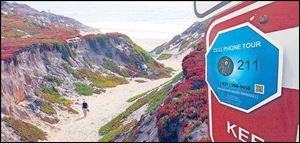
State parks starting to phone it in
Visitors can access guided audio tours of parks via cellphone
8/10/2011
A sign featuring a new cellphone tour that travelers can dial into at Fort Ord Dunes State Park in Marina, Calif. Once reviled by park rangers as an unfortunate distraction, cellphones lately are being embraced by national, state, and local parks as a way to educate a more connected public.
On the way out to explore the rolling white-sand dunes of Fort Ord Dunes State Park, California's newest state park, pause at the marine sanctuary lookout point to check out an illustrated map of Monterey Bay's underwater canyon.
While observing the breezy ocean splendor beyond, take out your cellphone, dial 831- 998-9458 and punch in the number 204. A recorded voice will give you information on the local migrating patterns of whales and where to see a nearby raft of sea otters, among other notable details. Elsewhere in the park, dial 206 and you can listen to Dave Dixon, a retired ranger, talk about the snowy plovers that nest on the beach (and how they can get spooked by dogs out for a ramble, so rein in those canines).
Once reviled by park rangers as an unfortunate distraction, cellphones lately are being embraced by national, state, and local parks as a way to educate a more connected public. Fort Ord Dunes, on the Pacific coast about two hours south of San Francisco, features a new cellphone tour that hikers can dial into from the trail; it gives a guided walking tour of the cultural and natural history of the site, which used to be a military post and now is a protected habitat area for seals, sea lions and those endangered snowy plovers. Numbered placards help situate visitors using the phone service for location-specific viewing information.
"We've been trying out the cellphone tours as part of a pilot group in the park system," said Dana Jones, the superintendent of the Monterey District for California State Parks.
She also said that feedback for the project has been positive.
First opened in 2009, the park, which spans almost 1,000 acres, has gorgeous panoramas of Monterey Bay, a boardwalk and viewing platform, and a 1,500-foot trail that leads down to a four-mile stretch of beach. In April, the park also opened four miles of repaved hiking and biking trails, on the inland side of the park's coastal dunes, running along what was once military shooting ranges. There are several new interpretive signs that describe the area's history as training range for soldiers since World War I.
Cellphone hiking tours are also popping up in parks run by the National Park Service as well as other more regional nature preserves. At Fort Baker in the Golden Gate National Recreation Area in and around San Francisco, visitors can take a cellphone tour that covers the military history and the natural surroundings of tranquil Horseshoe Cove, a critical habitat for Chinook salmon, just north of the Golden Gate Bridge. And in the Jean Lafitte National Historical Park and Preserve in Louisiana, a cellphone option is available to hikers looking to learn as they explore the bayous and swamps of the lush wetlands of Barataria Preserve.
In the old-growth deciduous forests of western Ohio, the Cincinnati Nature Center's "Nature Calls" tours (cincynature.org) cover 20 miles of trails, offering a series of messages recorded by staff naturalists that detail wildflowers, pond ecosystems and the geological history of rocks and fossils along the way. (The tours move to new locations each season to maintain variety.) And in Southern California, the Quail Hill Preserve in the Irvine Ranch National Landmarks offers a cellphone nature tour (irlandmarks.org) in which naturalists and researchers explain distinctive features along the trail, including vernal pools and red-tailed hawks.